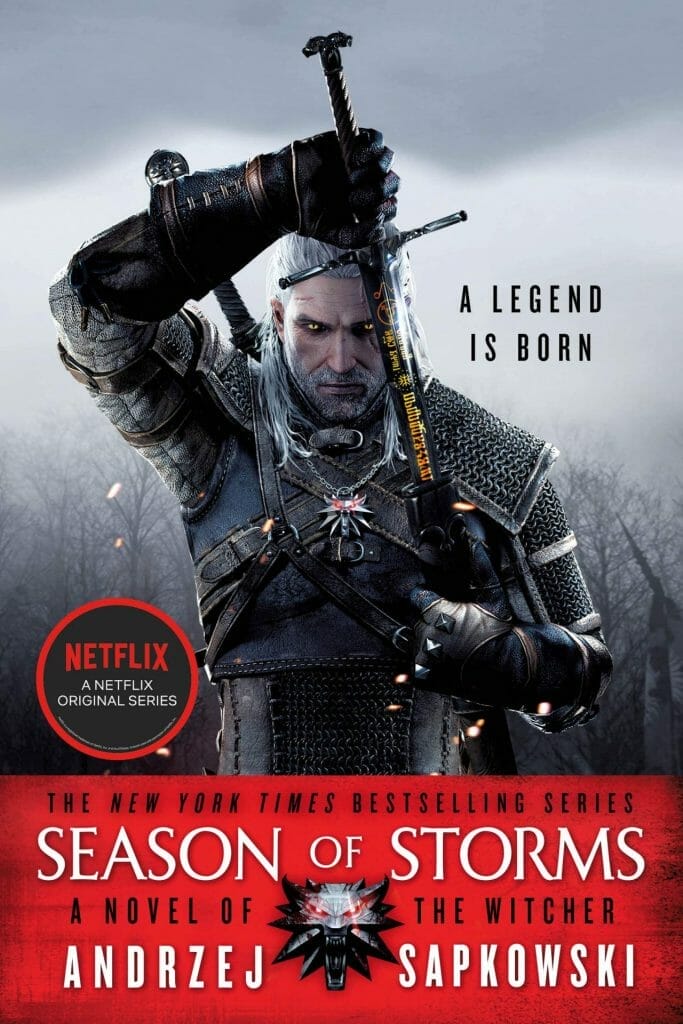Seasons of Storms is the sixth novel in Andrzej Sapkowski’s “Witcher” series, following the events of The Lady of the Lake. The novel follows the witcher, Geralt of Rivia, as he sets off on his quest to retrieve a valuable stolen artefact.
If you’re like us and binged the Netflix show in one weekend and put countless hours into The Witcher video game, then the only next step is to take a look at the epic novels that inspired not one, but two different media adaptations!
This is the sixth novel in the Witcher series (but the eighth overall in The Witcher Saga). So make sure you’ve checked out Lady of the Lake first! Otherwise, let’s take a look at another stop in this epic fantasy ride.
Table of Contents [CLICK HERE TO OPEN]
Official Description

The Lady of the Lake
Geralt of Rivia is a Witcher, one of the few capable of hunting the monsters that prey on humanity. He uses magical signs, potions, and the pride of every Witcher—two swords, steel and silver.
But a contract has gone wrong, and Geralt finds himself without his signature weapons. Now he needs them back, because sorcerers are scheming, and across the world clouds are gathering.
The season of storms is coming. . .
“It’s good to feel fear. If you feel fear it means there’s something to be feared, so be vigilant. Fear doesn’t have to be overcome. Just don’t yield to it. And you can learn from it.”
Andrzej Sapkowski, Season of Storms
Our Overview
We return to the epic saga with Geralt being hired by a powerful sorceress named Coral to retrieve a stolen artifact. The zephyr is a powerful magical device that can manipulate the weather. Geralt sets out on his quest, but things rarely go to plan in this world. He is ambushed by a group of bandits who steal the zephyr from him. He is then forced to retreat and regroup, but in doing so, he ends up getting caught up in a web of political intrigue and betrayal that spans multiple kingdoms.
Geralt teams up with a group of unlikely allies, including an elven warrior named Ihuarraquax, a bard named Dandelion, and a medic named Shani. Together they plan to track down the zephyr and uncover the truth behind its theft. In their journey, they meet plenty of formidable foes, resulting in a seemingly endless slew of battles.
As they journey across the land, Geralt and his companions become embroiled in a complex plot involving several powerful factions vying for control of the zephyr. These include a group of sorcerers led by Coral, who seek to use the device to further their own agendas, and a group of scientists who want to study its magical properties.
Geralt and his team are eventually able to retrieve the zephyr and prevent it from falling into the wrong hands. However, the adventure takes a toll on them all, and Geralt is left questioning his place in the world and the purpose of his never-ending quest for justice.
Our Review
The Witcher Wiki states that this standalone novel is a midquel, set before “The Witcher” short story but after most of the other stories in The Last Wish. We should state, however, that this novel feels more in-tune with the main series than the short stories.
Instead of character and point of view hopping which was introduced in Blood of Elves and continued up until The Lady of the Lake, we only follow Geralt’s actions here. This is with the exception of certain interludes which include letters, a story draft, and the happenings at an auction house. It was nice to have a change in perspective at this point of the series, but the interludes kept us really clued-in to what was happening in the world outside of Geralt’s perspective.
This novel is technically a standalone, but we would advise against reading this without reading the short story prequels at least. Personally, we like it nestled in within the main storyline and have labeled it as such.
It has all the things that we thoroughly enjoy about Sapkowski’s world: rich worldbuilding with historical allusions, modern themes raised in the medieval setting and a lonely path of a hero in a cynical world around him. Geralt’s morals are a strong candle in this novel, and he is tried seemingly at every corner.
This was an excellent addition to the series no matter how you read it! Although we don’t recommend it as a standalone, it definitely has its home as an introduction to the series, a nice mid-point break, or as a bitter-sweet farewell to the series. Its adaptability makes it an easy novel to fit into your reading schedule.
Our rating: ★★★★★
Check it out on Netflix
Frequently Asked Questions
Do I need to have read the other Witcher books before reading Season of Storms?
Technically, no. The novel is intended as a standalone novel in the Witcher verse. However, we strongly suggest that readers have explored the prequel short story collections prior to picking up this novel.
Is Season of Storms a good starting point for someone new to the series?
Absolutely! After reading the prequels, or even using this novel to start the main novels with, Season of Storms is perfect to start your Witcher journey with! It does assume some knowledge of the world and its characters, hence why many suggest reading it after the short stories, which act as a good foundation to the world.
How many Witcher books are there?
There are a total of 9 books in the series, which include 3 short story collections, 5 main novels and a standalone novel.
- The Witcher (1990)
- Sword of Destiny (1992)
- The Last Wish (1993)
- Blood of Elves (1994)
- Time of Contempt (1995)
- Baptism of Fire (1996)
- The Tower of the Swallow (1997)
- The Lady of the Lake (1999)
- Season of Storms (2013)
How does “Season of Storms” compare to the other Witcher books?
Opinions on the novel vary, which is very common when a ‘standalone’ novel is released concurrent to a series. Generally, people enjoyed it as a means to delve more into the character of Geralt. However, some people mention that the novel felt like there was less at stake, due to it being a standalone.






